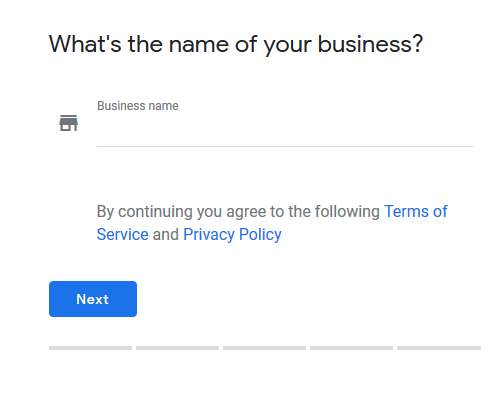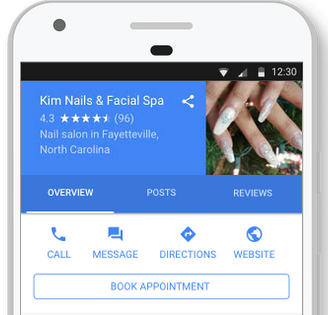It’s your business. You’d better claim it.
Google makes that possible through a service known as My Business. If you’ve ever been frustrated because you’ve Googled your business—only to find that not only did you not show up, but your site didn’t get all of the fancy bells and whistles the competition did—My Business is where you need to start.
This free service isn’t just “nice to have.”
It’s essential.
But if the process of setting up and optimizing this listing for maximum impact seems like more than you can handle in an afternoon, that’s understandable.
That’s why I’ve put together a comprehensive guide to setting up and optimizing Google My Business listings:
Why Bother with Google My Business Listings?
In one sentence: because it puts you in charge.
Once you claim your business and go through the application process (see the next section), you’ll be able to update customers as to your address, phone number, hours of operation—and change it all for holidays and special events, all from the comfort of your own smartphone. Here are a few other benefits to keep in mind:
- Potential clients can book time with you directly through the listing, increasing conversion potential.
- You can review customer activity on your Google dashboard.
- The service is free to use, with no recurring costs.
- You’ll increase the legitimacy of your business when you have a fully-realized Google listing when someone searches your name.
How to Set Up Google My Business Listings
It begins with a simple application process to verify that you are the business that you say you are.
If you’ve so much as signed up for a Gmail account before, you know that this won’t take you long.
It’s once your business is registered that you can really get in and tweak your business profile the way you like it. Make sure that you have the following information handy:
- Business name
- Address
- Hours/days worked
- Phone number
- Category of business

Above: see? Not so hard.
You won’t find anything here you haven’t answered before.
One key thing you’ll want to remember here: anyone can suggest edits on your My Business listing.
If someone disagrees about your working hours, for example, they can click “Suggest an Edit.”
Think of Google’s My Business Listings as something of a “Wikipedia entry” for your business.
To stay on top of it, set a calendar reminder every few weeks to just spend a minute or so and Google your business to see if the listings are as you intended. Although Google should send you notifications when this occurs, it doesn’t hurt to stay on top of it yourself.
Understanding “Answer Quick Questions”
As you browse through a Google listing for a business to get an idea of what you’re in for, you’ll likely come across a sentence that says “Know this place? Answer quick questions.”
What’s going on here?
In short, this is an option that allows Google’s user network to answer questions about your business—what kinds of services you provide, whether your hours may be true to life, etc.
What’s important to remember about this section is simple: you don’t have total control here.
Yes, it might be a good idea to encourage a few of your customers to answer these questions for the sake of accuracy, but don’t expect that you’ll ever have full dictatorial control over this part of your listing.
Google Posts: Worth Your Time?
Underneath your listing, you’ll notice there’s space for you to create your own content and publish it directly to Google.
What kind of content should you post here?
It’s not exactly a blog listing. If you want to create truly long-form, valuable content—post it to your website and your social media.
But there are plenty of posts you can use on Google Posts to encourage customers to check you out, including:
- Special offers.
- Updates to your business.
- Notifications about hours and scheduling.
- New services offered.
- New locations served.
Think of this part of your My Business Listing as your own bulletin board. Only those who seek your business out are likely to see it, but if you receive enough searches through Google, it’s worth posting these directly.
Booking Business Through Your My Business Listing
One of the most intriguing ways to use My Business—especially as a service-based listing—is as a passive collector of potential leads.
Source: Google

This is particularly great on mobile, as you can see above: the key buttons make it possible to call, message your business, or even book an appointment right then and there.
This might be the fastest way to reduce client “friction” ever invented.
The key here is that you have to already be using scheduling software that fits within Google’s framework. You can find a list of Google’s compatible software here.
If your web goal is to convert visitors into potential clients, a sit-down meeting might be the best thing that happens to you. Take full advantage of this feature if you want to make it easier on your leads.
Setting Up Messaging With Leads
Maybe a potential lead isn’t quite ready to sit down with you yet—but they’re intrigued.
Do they have options with My Business?
They do—in fact, they can message your business if you’ve taken the time to set up that aspect of the platform.
A word of warning here: if you have a lot of Google traffic, you’re going to need to be able to handle a high volume of messages. And you’ll probably want to use a dedicated business phone rather than your private cell phone.
Failing that, you can always use a service like Grasshopper to add a business line to your existing phone, separating the two types of calls.
Google also uses an app called Allo to make it more practical to deal with a large number of customers. Don’t worry—if the calls get to be too much, you can turn off messaging at select times during the day as well.
Optimizing Your Google My Business Listing
Now that you have the basics down, let’s talk about making the most of your My Business listing.
Reviews
In the online world, don’t forget that your reputation hinges largely on reviews.
The best way to ensure you get good reviews, of course, is to offer the best client service possible. But even those businesses that are diligent and thorough will occasionally have random Internet users casting aspersions.
Google allows businesses to ask customers for reviews, provided that these reviews fall within the confines of Google’s guidelines.
Visuals
A picture is worth a thousand words.
When you have a Google My Business listing, your company has some prime real estate on one of the most trusted places on the web.
It’s important to make full use of that space.
Use visuals of your company. It may even be worth it to have a professional photographer come in and highlight different aspects of your business.
The professionalism of your photography sends a clear message: not only are you a real business, but you’re a business that takes itself seriously. That’s exactly what you want to come across in your business listing.
Descriptions
It’s also vital to have a thorough, well-crafted description for your business.
The tone here is important. Light-hearted ice cream shops can have all sorts of fun. But you also have to consider who your audience might be.
What kind of description would make you trust a company like yours?
You can outsource this type of work to a freelance writer or craft one yourself.
Monitoring Customer Activity
If you want to ensure that your My Business listing is doing all it can to funnel new potential leads to your website and to your business, it’s important to keep some analytics going.
Google makes this possible through a free dashboard in which you can monitor your customer activity.
Although it’s important to avoid the temptation to make small changes every time a new customer visits your page, it is important to regularly review analytics like your Google My Business listing to get a sense of working and what isn’t.
Try to see things from the customer’s perspective and continually improve your listing.
Filling In More Information
The more information you have on your business listed, the better.
This increases customer trust.
For example, consider the last time you Googled a restaurant. If they didn’t have a website and didn’t post their menu information online, that felt somehow…off, didn’t it?
That will be the case with your business if you avoid putting up essential information as well.
You’re not a restaurant. You don’t have to put up a menu.
But you should try to explore your My Listing page to find out what a business of your type can deliver.
You want to instill trust here, not make a sales pitch. But remember that this is an indirect sales letter for your office.
Make it count.
Getting to Work on Your Google My Business Listing
When you do it right, a Google My Business Listing can be a major blessing. It can point potential clients in the right direction. It can fit neatly into your already-existing web infrastructure.
The key here: take a methodical approach.
Don’t be afraid to dip your toes in the water, so to speak. And keep utilizing all of the features with Google My Business until you’ve run out of ideas.
Your leads will thank you.








